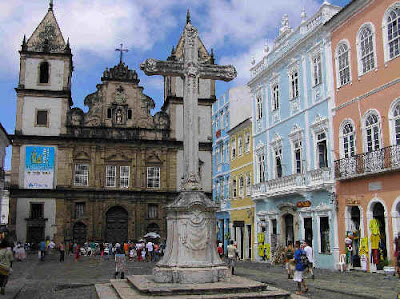Baroque Bahia´s Church interior. From http://www.seasonsporttour.com/igf/novas_imagens/Bahia/182.jpg
From UNESCO list of the World Heritage Monuments: As the first capital of Brazil, from 1549 to 1763, Salvador de Bahia witnessed the blending of European, African and Amerindian cultures. It was also, from 1558, the first slave market in the New World, with slaves arriving to work on the sugar plantations. The city has managed to preserve many outstanding Renaissance buildings. A special feature of the old town are the brightly coloured houses, often decorated with fine stucco-work.
I’m presenting today, Umberto Eco’s great description of San Salvador da Bahia de Todos os Santos’s baroque churches in his book Foucalt’s Pendulum.
Bahia´s baroque church. From http://www.colonialvoyage.com/viaggi/brazil71.jpg
Facade of Cathedral, San Salvador da Bahia, Brazil. From http://www.studylanguages.org/images/salvadordabahia/cathedral-salvador-bahia.jpg
Cloister of Convent of San Francisco/Sao Francisco, Salvador, Bahia. www.colonialvoyage.com/viaggi/brazilsalvador.html
“ And I saw Salvador: Salvador da Bahia de Todos os Santos, the “black Rome,” with three hundred and sixty five churches, which stand out against the line of hills or nestle along the bay, churches were the gods of the African pantheon are honored.
Amparo knew a primitive artist who painted big wooden panels crammed with Biblical and apocalyptic visions, dazzling as a medieval miniature, with Coptic and Byzantine elements. …..he spent his days dreaming in the sacristies of the sanctuary of Nosso Senhor do Bomfim: a triumph of horror vacui, scaly with ex-votos that hung from the ceiling and encrusted the walls, a mystical assemblage of silver hearts, wooden arms and legs, images of wondrous rescues from glittering storms, waterspouts, maelstroms. He took us to the sacristy of another church, which was full of great furnishings redolent of jacaranda. “Who is that painting of?” Amparo asked the sacristan. “Saint George?”
The sacristan gave us a knowing look. “They call him Saint George,” he said, “ and if you don’t call him that, the pastor gets angry. But he’s Oxossi.”
For two days the painter led us thorugh naves and cloisters hidden behind decorated facades like silver plates now blackened and worn. Wrinkled, limping famuli accompanied us. The sacristies were sick with gold and pewter, heavy chests, precious frames. Along the walls, in crystal cases, life-size images of saints towered, dripping blood, their open wounds spattered with ruby droplets; Christs writhed in pain, their legs red. In a glow of late-Baroque gold, I saw angels with Etruscan faces, Romanesque griffins, and Oriental sirens peeping out from the capitals.
I moved along ancient streets, enchanted by names that sounded like songs……At the feet of those deserted and leprous churches embarrassed by their own evil-smelling alleys, fifteen-year-old black prostitutes still swarmed, ancient women selling African sweets crouched along the sidewalks with their steaming pots, and hordes of pimps danced amid trickles of sewage to the sound of transistor radios in nearby bars. The ancient palaces of the Portuguese settlers, surmounted by coats of arms now illegible, had become houses of ill-repute.”
Convent and Igreja de São Francisco, Salvador (Bahia). Abaroque church with a beautiful azulejos cloister. Forced to build their masters' church and yet prohibited from practicing their own religion (Candomblé), the African slave artisans responded through their work: the faces of the cherubs are distorted, some angels are endowed with huge sex organs, some appear to be pregnant. Text and picture from www.colonialvoyage.com/viaggi/brazilsalvador.html
Bahia´s Church Interior. By Tony Galvez
San Salvador da Bahia. From http://abagond.files.wordpress.com/2008/08/salvador_da_bahia_church_brazil.jpg








So Good post and i will follow you Blog and i hope to follow my blog Ancient Egyptian Gods and Goddess and see more about Horus Egyptian God thanks a gain admin ,,,
ReplyDeleteThank you Anonymous, I love Eco´s description of these churches.
ReplyDeleteThank you, Myriam. As I prepare to visit Salvador with my samba drumming buddies (Unidos da Filadelfia) I will suggest they look at your presentation of the churches with Umberto Eco, as well as some Jorge Amado stories....
ReplyDelete